This post contains affiliate links. Please see our disclosure policy.
These core exercises for seniors are an easy and effective way to enhance your strength and stability. My expert workout is perfect for at-home workouts, and you can start today!
Ab workouts aren’t limited to athletes and the under-30 crowd. As a matter of fact, seniors rank as one of the top groups who should be doing core strengthening exercises on a regular basis.
As we age, it’s important to maintain our physical health and fitness level, and core exercises are a great way to achieve that. Your core encompasses your ab muscles as well as your back muscles.
Not only do these exercises help build overall strength, but they also improve balance and stability, reduce lower back pain, and enhance good posture. And no, I’m not just talking about crunches and sit-ups!
These are the best core exercises for seniors to help build strength and improve overall stability.
Workout Instructions
- Perform each exercise move for 5-10 repetitions (per side) for a great core workout in less than 10 minutes!
- Aim to complete these exercises daily to keep core muscles strong and healthy.
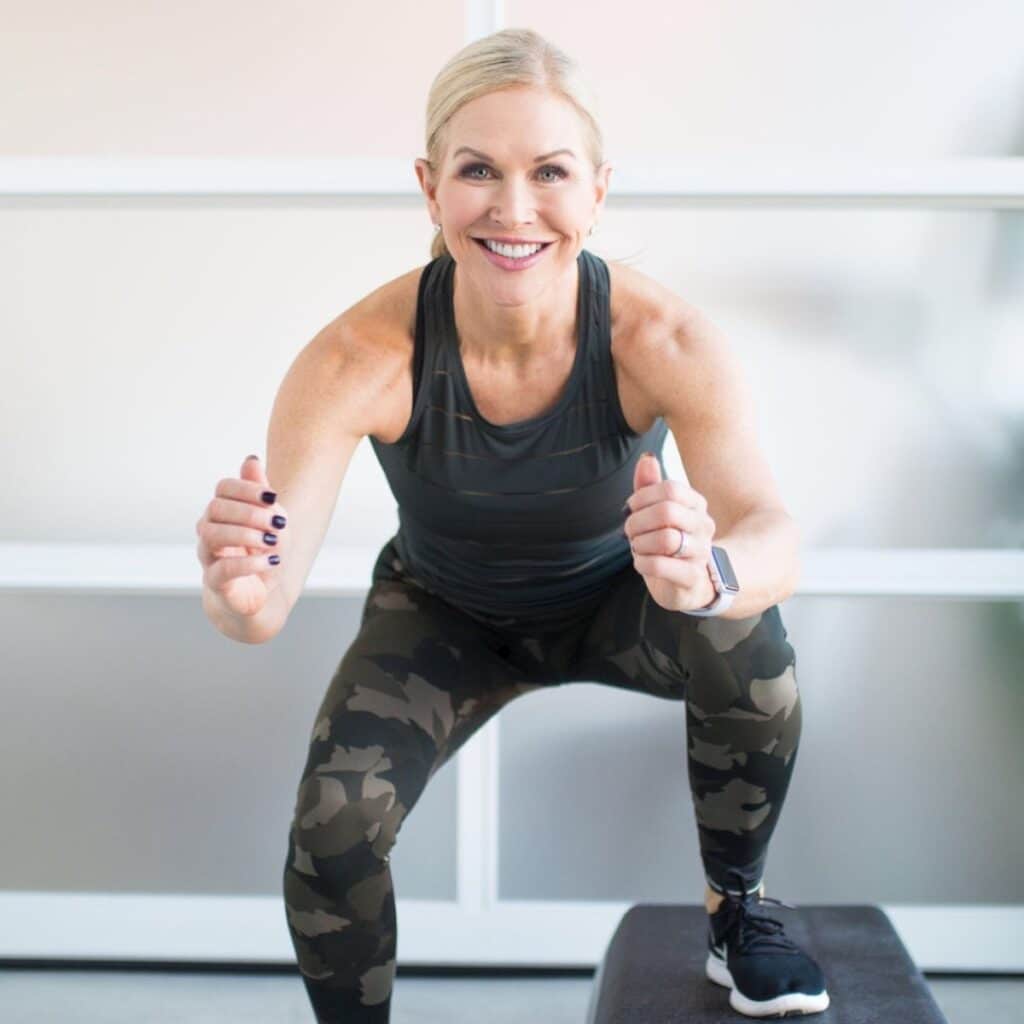
Save This Article To Read Later
Table of Contents
- 1. Seated Forward Roll-Ups
- 2. Seated Side Bends
- 3. Seated Leg Lifts
- 4. Seated Leg Taps
- 5. Seated Half Roll-Backs
- 6. Forearm Planks
- 7. Superman
- 8. Glute Bridges
- What Is Your “Core”?
- Why Core Exercises for Seniors Matter
- How Long Will It Take to Strengthen Your Core As A Senior?
- Safety Tips for Seniors When Doing Core Exercises
- Additional Core Workout Guides
- Other Exercise Resources for Seniors
1. Seated Forward Roll-Ups
In the seated forward roll up exercise you will engage core muscles in a slow controlled movement perfect for any age!
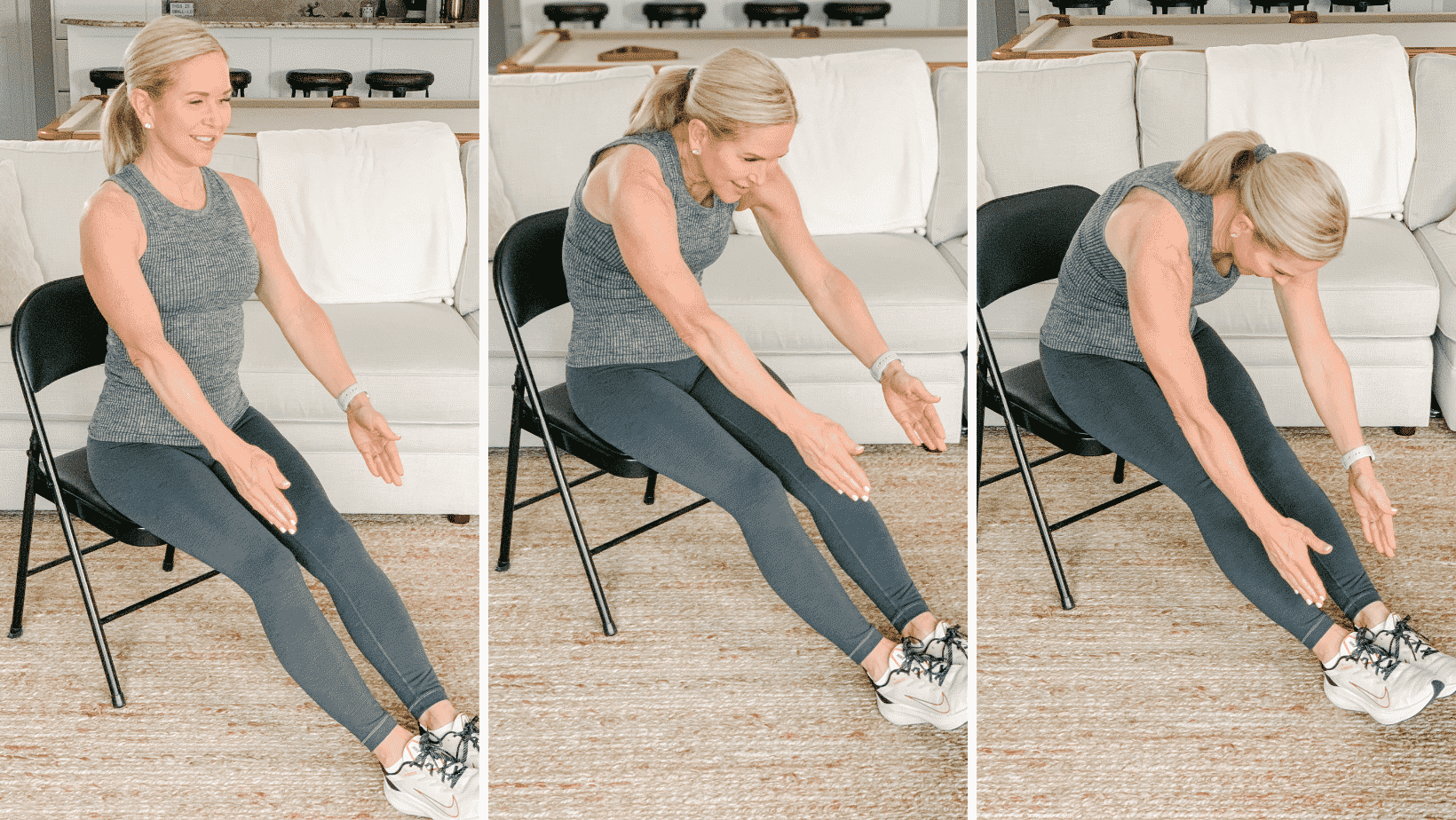
How to Perform a Seated Forward Roll-Up:
- Sit in a chair with your legs extended, heels on the floor, and feet flexed towards your face. Extend your arms in front of you. Keep an upright posture; don’t slouch or lean back in the chair.
- Begin curling your chin to your chest. Exhale as you roll the entire torso up and over, keeping your legs straight, abs engaged. Reach down towards the toes.
- Once you can’t reach any further, inhale as you begin to roll back up to the starting position, one vertebra at a time.
- Repeat moving slowly. Avoid using momentum; try to use your abdominals to lift and lower.
Muscle Groups Targeted: Rectus Abdominis, Transverse Abdominis
2. Seated Side Bends
The seated side bend exercise stretches your oblique muscles by leaning to one side, while maintaining alignment and stability.
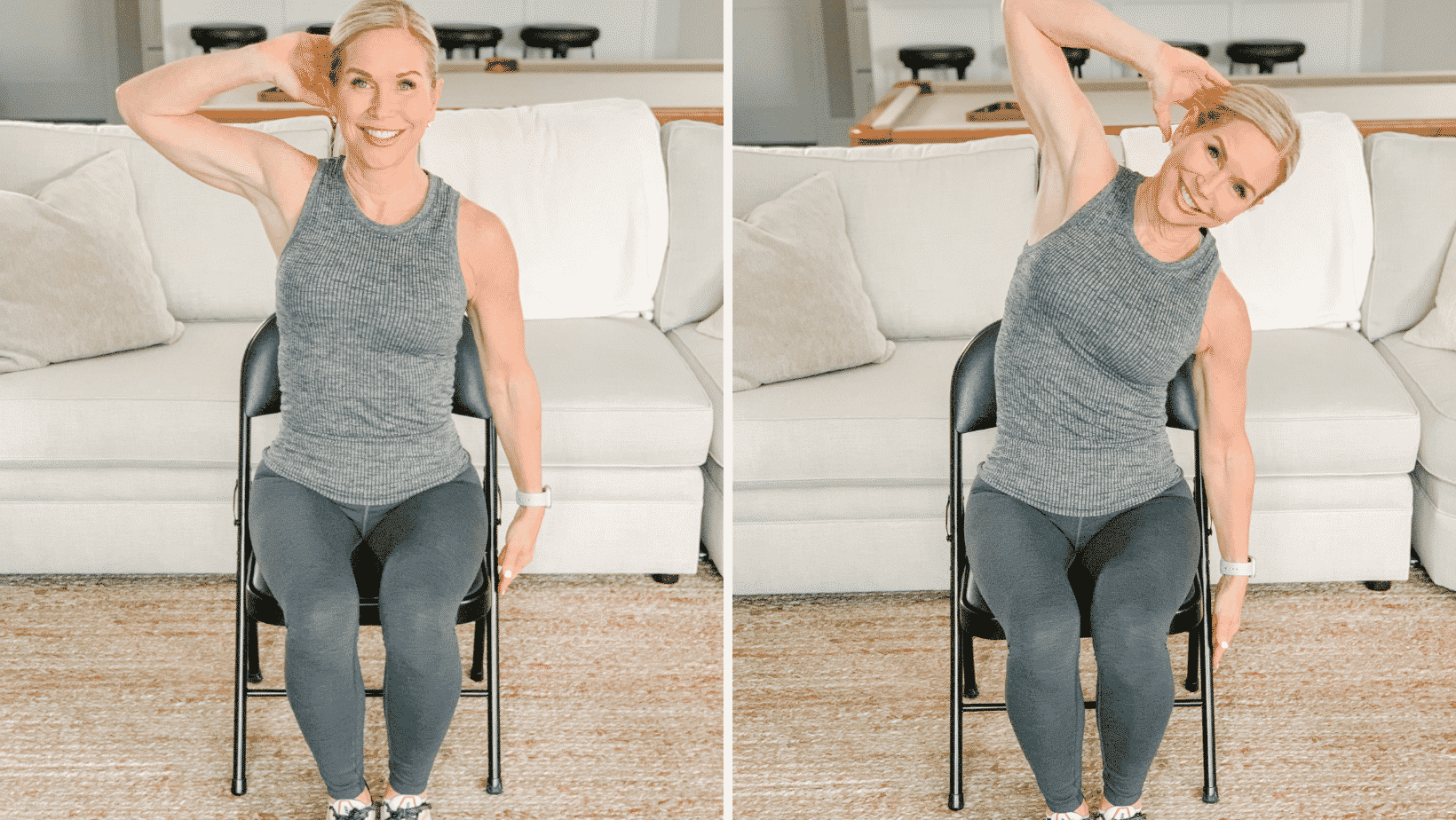
How to Perform Seated Side Bends:
- Sit with knees bent and feet flat on the ground. Bend your right arm to bring your right hand to the right side of your head. Allow your left arm to hang at your side. Keep an upright posture; don’t slouch or lean back in the chair.
- Inhale. As you exhale, bend gently at the waist to lower your left arm toward the floor. Keep your chest open and pull your right elbow back to feel a stretch in your right side.
- Inhale to return to starting position. Repeat.
Muscle Groups Targeted: Internal and External Oblique Abdominal Muscles
3. Seated Leg Lifts
The seated leg lift is a great core exercise for seniors because it engages your core muscles while targeting lower abdominal muscles and your hip flexors.

How to Perform a Seated Leg Lift:
- Sit in a chair. Your left knee should be bent with your left foot flat on the ground, and your right leg extended. Keep an upright posture; don’t slouch or lean back in the chair.
- Engage your core to raise your right leg. Lift your leg as high as you can without letting your back collapse. Hold briefly before returning your foot to the floor.
Abdominal Muscles Targeted: Rectus Abdominis, Transverse Abdominis, Internal and External Obliques
4. Seated Leg Taps
These seated leg taps will engage your core muscles for stability, while strengthening your lower abdominal muscles and hip flexors.

How to Perform Seated Leg Taps:
- Sit in a chair with knees bent and feet flat on the ground. Keep an upright posture; don’t slouch or lean back in the chair.
- Hold onto the bottom of your seat for support. Engage your abdominals and extend both legs out in front of you, tapping the floor with both feet.
- Reset by pulling your legs under your chair, allowing your feet to rest on the floor. When you’re ready, repeat.
Muscle Groups Targeted: Rectus Abdominis, Transverse Abdominis
5. Seated Half Roll-Backs
This seated half roll back exercise focuses on spinal articulation and abdominal control, all while strengthening your core muscles.
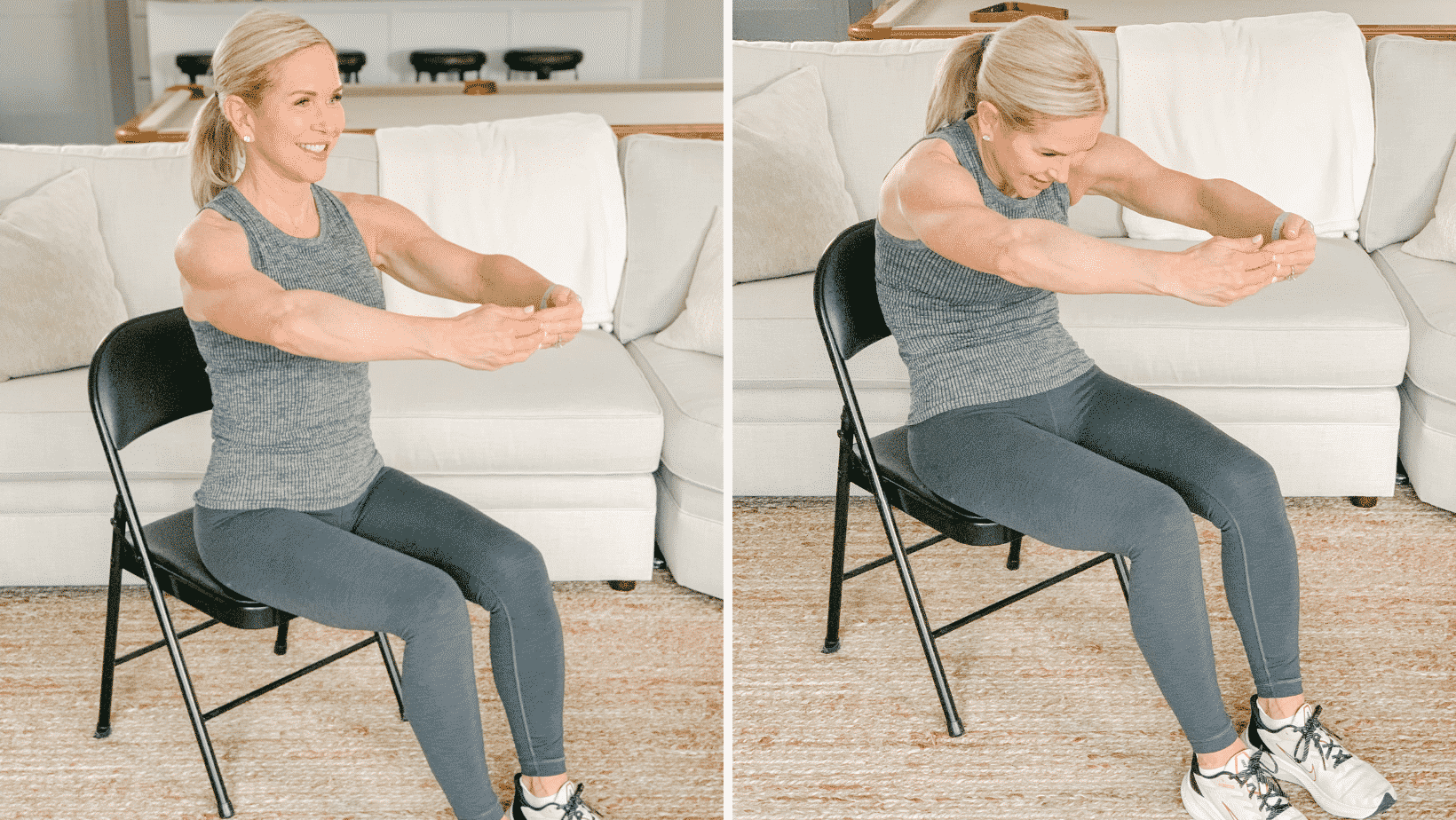
How to Perform a Seated Half Roll-Back:
- Sit in a chair with knees bent and feet flat on the ground. Lift your arms in front of your chest to create a circle. Keep an upright posture; don’t slouch or lean back in the chair.
- Keeping your feet on the floor and your arms joined in a circle in front of your chest, begin to round your back. As you round your back, think about scooping your abdominals.
- Once you can’t go any further, engage your abs as you slowly roll back up to the starting position.
Muscle Groups Targeted: Rectus Abdominis, Transverse Abdominis
6. Forearm Planks
The classic forearm plank is an amazing way to build strength and stability and engage your core muscles at the same time.
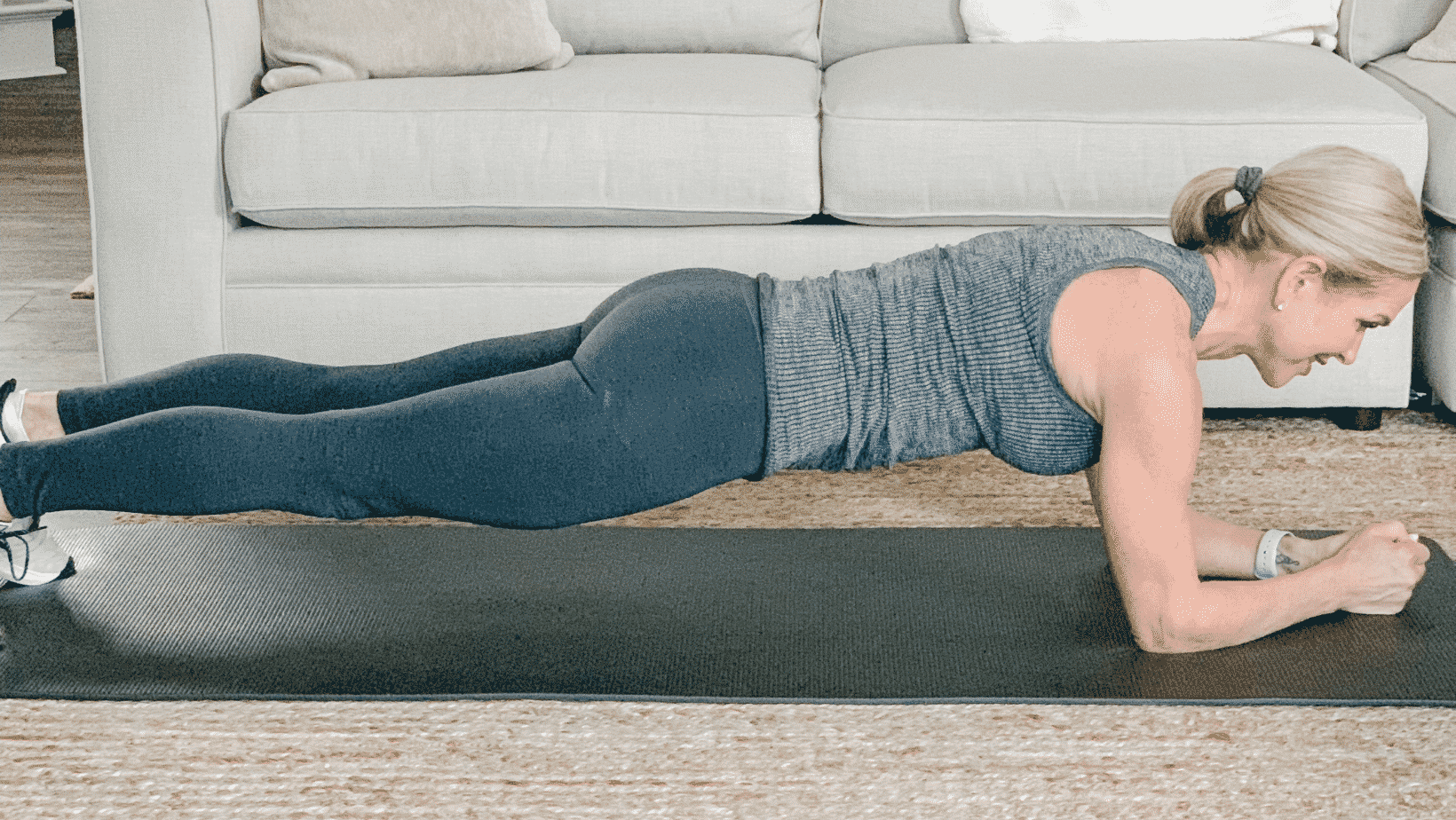
How to Perform a Forearm Plank:
- Lie face-down on the floor with your forearms on the ground. Your elbows should be directly under your shoulders and hands flat on the ground, elbow-width apart.
- Engage your core to prepare. Then, press down through your forearms to raise your body off the floor until you’re supported by your forearms and toes.
- Keep your body in a straight line from your head down to your feet. Pull your navel into your spine and squeeze your glutes to keep your hips from dropping toward the floor.
- Hold for 30 seconds or 1 minute if you’re more advanced.
Modifications: Drop down to your knees if you can’t keep your hips in line with your shoulders, or you feel pressure in your lower back.
Muscle Groups Targeted: Rectus Abdominis, Transverse Abdominis
7. Superman
This superman exercise engages your core and back muscles promoting better spinal extension and muscle strength.
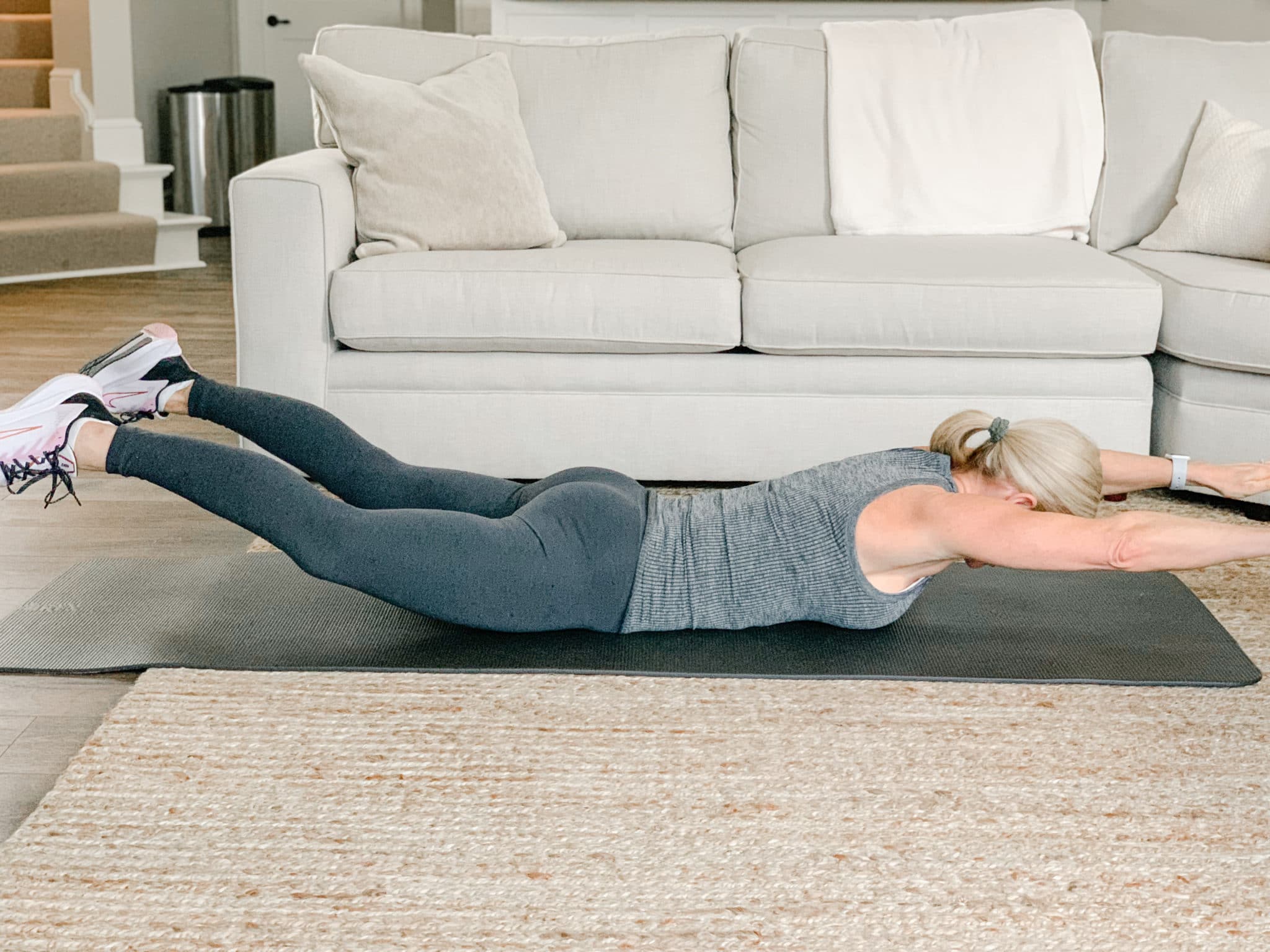
How to Perform a Superman:
- Lie on your stomach with your legs long. Extend your arms overhead. Draw your abdominals up and away from the ground, and pull your shoulders down away from your ears.
- Engage your abs, back muscles, and glutes to lift your arms and legs simultaneously off the ground. Keep your gaze on the floor.
- Release back to the starting position with control.
Muscle Groups Targeted: Obliques, Lower Back, Erector Spinae, Glutes
8. Glute Bridges
Strength exercises like glute bridges are a great way to effectively target and strengthen your posterior chain.
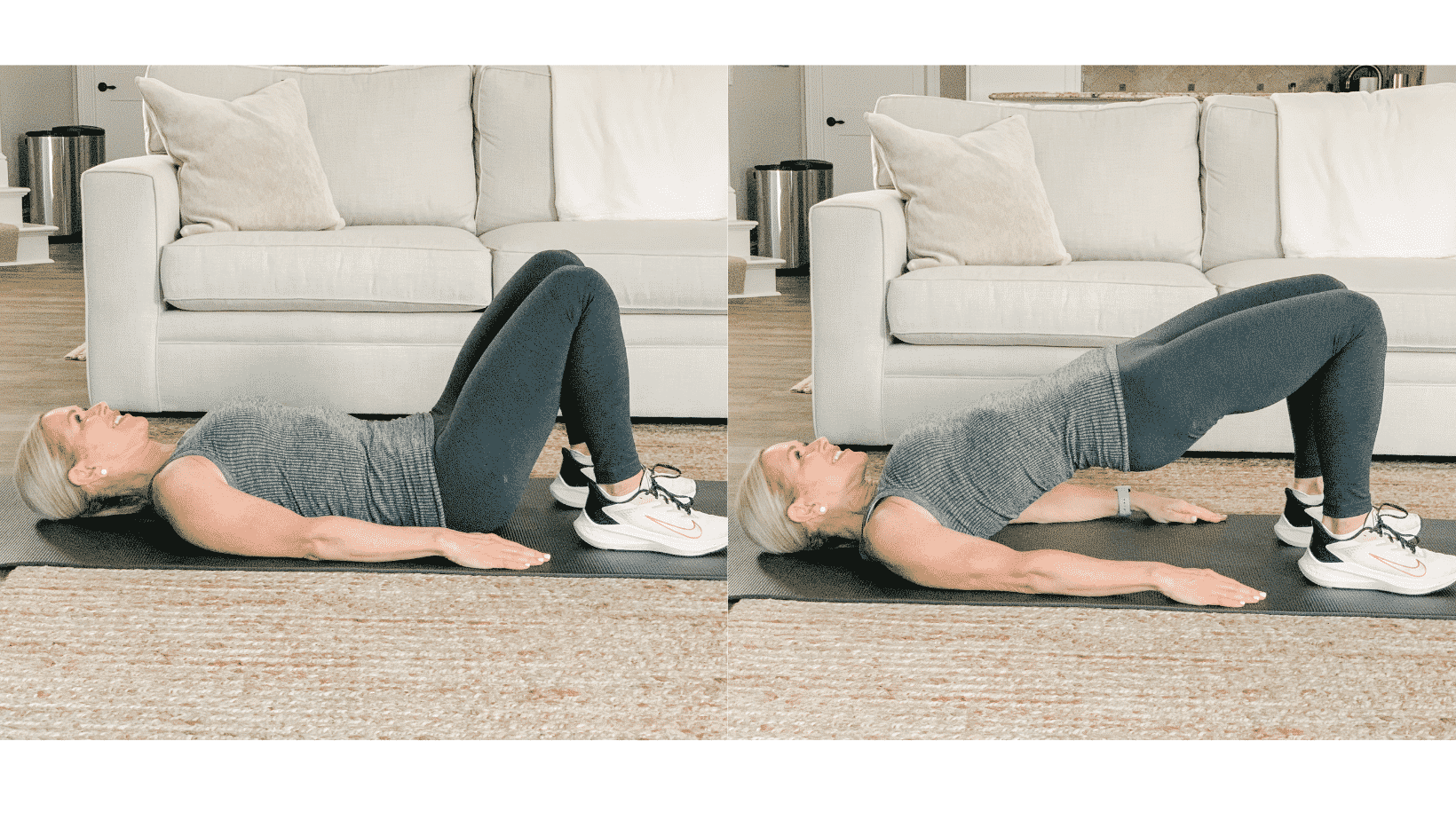
How to Perform a Glute Bridge:
- Lie on your back with knees bent and feet flat on the floor, hip-width apart.
- Engage your abs and squeeze your glutes to lift your hips to a bridge.
- Hold briefly and return your glutes to the floor with control.
Muscle Groups Targeted: Glutes, Hamstrings, Lower Back, Rectus Abdominis, Transverse Abdominis
What Is Your “Core”?
The “core” is more than just the visible ab muscles you see on display in popular fitness magazines. It’s made up of all the muscles in your trunk, which assist in nearly every movement you make.

Key Core Muscle Groups
These are the core muscle groups within your core:
| Glutes | The meaty muscle in your buttocks is called the gluteus maximus, and it helps propel you from seated to standing, power up a flight of stairs, and walk around the block. You also have the gluteus medius, which is a smaller muscle on either side of your buttocks that helps keep you steady while you stand, walk, or jog. |
| Rectus abdominis | The rectus abdominis is the main “six-pack” muscle that runs from your rib cage to your pubic bone. It primarily works to flex or bend your trunk. |
| Obliques | The obliques are made up of a pair of external oblique muscles — one on each side of your trunk — and a pair of internal oblique muscles, which are located just below the external obliques. Together, these muscles twist and bend your trunk from side to side. |
| Transverse abdominis | The transverse abdominis is your deepest ab muscle. It helps with breathing and works to stabilize your pelvis and low back. |
You also have your pelvis, low back, hips, and psoas muscles that make up the core body. They help to bend and straighten the spine and keep it stable during activity, as well as connect your legs to your trunk.
Keep reading to see my favorite core exercises for seniors that will target all of these muscle groups!
Why Core Exercises for Seniors Matter
Core exercises are essential for seniors because they offer numerous benefits that improve overall health and wellness. By engaging in core exercises regularly, seniors can build strength, endurance, and stability, which are all crucial for maintaining an active and independent lifestyle.
A few key benefits of core exercises for seniors include:
Improves Posture and Reduces Back Pain
Whether you’re moving or sitting still, your core muscles are in charge of keeping you upright. When these muscles are weak, we tend to slouch, causing back discomfort and pain.
Improving your core strength will keep your trunk upright and slouching at a minimum, which eases back pain over time.
If back pain is one of your issues, check out these simple back strengthening exercises for seniors, and my guide to using exercises to relieve back pain!
Helps With Everyday Activities
Strong core abdominal muscles make it easier to do the daily activities many of us take for granted, like walking up and downstairs, bending down to tie our shoes, and getting out of bed in the morning.
If you enjoy sports, core strength will help you swing a golf club, run a 5K, and swim laps more easily.
Improves Balance and Coordination
Many of your core abdominal muscles work to keep you stable while sitting, standing, and walking.
When these muscles are strong and healthy, they’re better able to do this all-important job, which allows you to maintain balance and coordination without much thought.
How Long Will It Take to Strengthen Your Core As A Senior?
The amount of time it will take you to strengthen your core muscles depends on how strong your core is, to begin with.
Core strength training should be a part of your weekly exercise routine. Make sure to aim for multiple repetitions a week for overall health.
A strong core takes time to build but will give you balance and stability for those daily activities you love to do.
Safety Tips for Seniors When Doing Core Exercises
As we age, we become more susceptible to injuries, especially during physical activities. When performing a core focused exercise program, it’s essential to prioritize safety and take precautions to prevent accidents.
Here are some safety tips and crucial guidelines for seniors to follow when doing these core exercises:
Proper Form
One of the most crucial aspects of any workout is proper form. Seniors should take time to learn the correct way to do lower abdominal exercises to prevent injuries. Engage the core muscles, keep the back straight, and avoid straining the neck during any movement.
Breathing Techniques
Seniors should utilize proper upper body breathing techniques during core exercises. Inhale deeply before starting the movement and exhale through the mouth slowly, engaging the core muscles during the exhale.
Breathing techniques can ensure proper oxygenation and prevent dizziness, crucial for seniors.
Warm-up Exercises
Prior to starting any workout, it’s crucial to perform warm-up exercises, especially for seniors. Gentle stretches of the back, neck, and legs are essential to loosen up muscles and prevent injuries.
Warm-up exercises also prepare the body for the actual workout and improve overall blood circulation.
Modifications as Needed
Lastly, seniors should always be mindful of their physical limitations and make necessary modifications during core exercises. Seniors with limited mobility can perform seated core exercises or use stability balls to ease the pressure on the back.
If any exercise causes pain or discomfort, seniors should discontinue it and consult their healthcare professional for guidance.
By incorporating these safety tips into core exercises, seniors can exercise with confidence and enjoy the numerous benefits of building core strength.
Additional Core Workout Guides
Once you’ve mastered the basics, you can dive into other types of core exercises!
- 15 Best Ab Workouts for Women: Total Core Exercises
- Ab Workout at Home: Best Core Exercises (No Equipment Needed)
- 20 Best Standing Ab Exercises for Women
- 8 Medicine Ball Moves to Sculpt Your Core
- Best Yoga Poses to Strengthen Your Core
- Best Lower Abs Workout for Women
The fact is, exercise and everyday living get harder as you age. And if you want to keep up your running or tennis habit, play with your grandkids, and generally be able to do things for yourself, you have to keep your body in good shape.
A weak core can get in the way of those activities. Adding core strengthening exercises for seniors into your weekly routine is a great way to make this happen!
Other Exercise Resources for Seniors
Our body changes as we get older, but that doesn’t mean we need to stop moving. We simply have to adjust! Regular exercise can help seniors stay active and avoid injury.
Maybe most importantly, it helps make daily life more enjoyable!
Here are a few of my favorite fitness resources for seniors:
- Pool Exercises for Seniors (30 Minute Workout Included!)
- 10 Effective Chair Exercises for Seniors
- Balance Exercises for Seniors (Video Included!)
- 9 Hip-Strengthening Exercises for Seniors
- 15 Best Mobility Exercises for Seniors to Stay Active
- 11 Simple Back Strengthening Exercises for Seniors
- Best Home Gym Equipment for Seniors

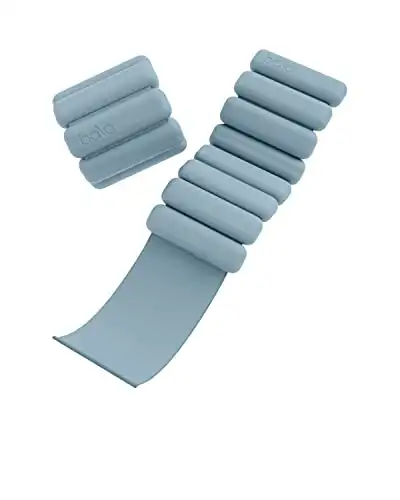
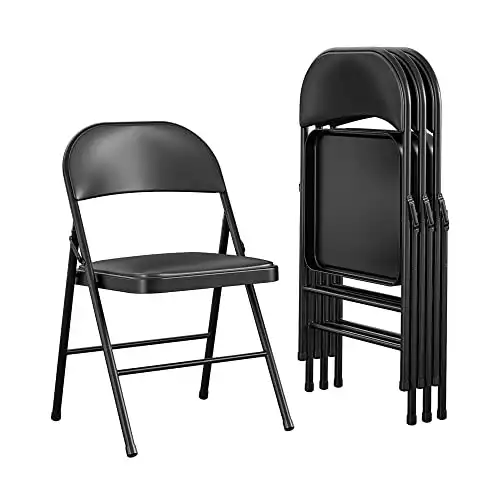



Hey there, it’s great content. I was thinking of buying a custom (resurge) diet need your opinion.
Hi there – I am not sure what you mean about a custom (resurge) diet. However, I am not a huge fan of diets, rather a healthy lifestyle is what I preach. You have to be able to eat nutritious food, while making it sustainable for years and years to come. Instead of a diet for a month or so, try to find a healthy way of living that will last you for years to come.
Hi Chris, thank you for a variety of exercises. As a woman in her 50’s diagnosed with osteopenia (like millions of others) any exercise that causes flexion of the spine, like crunches and forward bends, or twisting of the spine should be avoided. So I’m always on the lookout for substitutes for crunches and bicycles. You’ve given me a few more to add to my repertoire!
Would any of these exercises help improve a diastasis recti?
Great question 🙂 Absolutely. These will bring you great core awareness and will be good low impact options for core work. Have you also taken a look at our blog specifically about diastasis recti? You might want to check it out here: https://gethealthyu.com/how-to-get-back-into-exercise-with-diastasis-recti/
Hi Chris- I’ve been living w/MS for 17 years- diagnosed at 40. I forget about these core stretches- thank you so much! And your voice & presentation is so engaging & positive. 5 stars!
Mary
Hi Mary –
So happy to hear that you enjoyed these core exercises 🙂 Always here to help out when I can!
Hi
Thanks for the content. I’m diagnose with osteoarthritis and having severe pains deep in my heel and don’t feel comfortable to walk. Is there any exercise to get a relieve ? Tnks
How many times per exercise ? I’ve lost my core since COVID.. I find I weak with out and very afraid of rupturing my herniated disc
Hi Linda – great question. In the article it states to perform each move for 5-10 reps (per side) and you’ll get a great core workout in less than 10 minutes. Hope this helps and definitely work your way up! If you need to start at 5 first start there and work your way up to 10+ reps each exercise as you build strength!
What can I do instead of planks? I had big toe fusion and my big toe does not bend. Also, I get Costicondritis quite easily since an accident that I had.
Hi there –
Would a plank from the knees be an option as a modified version? The plank, even when modified on the knees, will engage the core, the shoulders, and the glutes in a different way than your regular crunches? I would suggest trying planks from your knees as an option. Otherwise I would try a full body roll up for another variation.
Let me know if you have any questions – I am happy to help!
Grazie per gli esercizi.Auguri di Buon Anno!
I was just reading some of your responses to the comments and I am so happy to hear you don’t promote heavy diets. In the past, I would just schedule a chiropractic treatment for any back or neck pain I had. However, I experience more pain at more frequent rates than before. I feel like I need to do a little more exercise to help maintain good health and avoid feeling that nagging pain. I think of all the exercises listed, I will probably do the glute bridges most often. I am excited to start trying these exercises and see if they make a difference.
Like info l